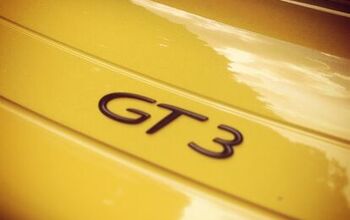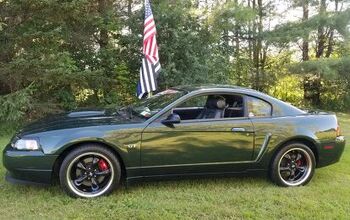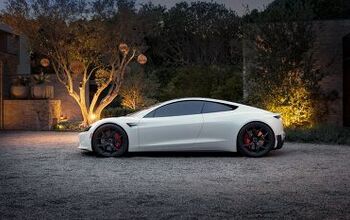Ownership Review: Porsche 911 GT3 (997 Vintage)

The last time my friend Derek allowed me to write for TTAC, I narrated a brief test drive of a Porsche 911 GT3 from the 996 generation, a a car that provided an intense and immersive driving experience, but that presented a heinous proposition as a sole car / daily driver, even for a young, single owner with a short commute in a sunny clime. Ostensibly, I had driven the car because I was considering replacing my old 911 with something more livable / less cantankerous / more rapid / etc. While that particular edition of the GT3 proved a poor match for my needs, I still resolved to join the 21st century by upgrading to a more modern car.
Springtime of 2014 represented a good opportunity to start shopping for a new conveyance, with several enticing and new or recently updated offerings both on the horizon and within my price range. I considered several options – even several non-Porsches! – including the Alfa Romeo 4C, the all-new F8X family of the BMW M3/4, the C7 Chevrolet Corvette Stingray Z51, and the 981 Porsche Cayman GTS. Those are all new cars, with full factory warranties. I’d learned my lesson owning an old German sports car with no factory repair safety net.
As I window shopped for new cars I also perused the Autotrader website and came across an intriguing advertisement for a 997 GT3. Since the car was introduced, I had intensely desired Porsche’s GT3 from the 997 family, and if Halicki’s Gone in 60 Seconds cult classic were improbably re-made to fit my biography, my “Eleanor” would be a 997 GT3. Unfortunately, the GT3 that was introduced when I was in high school violated the one sacrosanct rule of this entire exercise – the car was old and out of warranty. It also featured some frighteningly expensive components (new PCCB brake rotors would cost almost as much as I paid for the 993!).
However. The car was local. I knew the seller. The price was below market. The car was nicely optioned (blinged-out PCCB brakes, full leather, Xenon lights) and well-maintained, with a clean PPI, perfect DME over-rev report, and only 14,000 miles from new.
I called the owner and bought it over the phone for the full asking price, 100% sight unseen, in less than five minutes. I broke all of the rules. I did it for two reasons: 1 – I desired the GT3 moreso than any of the other options, and would have chosen a GT3 over any of them if finances were of no concern. 2 – The attractive entry price, coupled with the dynamics of the GT3 market mean that I’m unlikely to suffer any meaningful depreciation. In fact, I’ve been using the car as my primary vehicle / daily driver now for six months and plan to continue doing so for another year or two before selling it for about what I paid, perhaps a bit more.
So what’s it like?
Driving Experience:
Engine:
The defining feature of every GT3 from the 996 and 997 generations – up to and including the 4.0 RS zenith of the series – is the race-derived engine that Porsche nerds refer to as the “Mezger” engine, so named for Porsche’s visionary engineer, Hans Mezger, who designed the very first 911 engine, and whose very last project for Porsche was the development of the turbocharged lump that powered the 911 GT1 prototype that triumphed at Le Mans in 1998. That pedigreed block forms the basis for the production car engine, and in 997.1 GT3 guise it displaces 3.6 liters (100mm bore, 76.4mm stroke), producing 415 bhp and 300 lb-ft of torque. Performance is produced courtesy of high revs (8,400 RPM redline) and high compression (12.0:1); peak power output comes at 7,600 RPM, with peak torque entering at a lofty 5,500 RPM. While power delivery is, uh, peaky, the engine is sufficiently tractable and civilized at low RPMs. I’ve enhanced the car with a bypass exhaust from NorCal Porsche tuner Sharkwerks (mine is serial number 639 – it’s rather popular among the small community of GT3 devotees) and forced the exhaust valves to remain open all the time in order to drop 20 pounds from the rear, create an exceedingly antisocial racket and, most importantly, paint a big grin on my face every time I drive the car.
I cannot overstate the engine’s central role in my enjoyment of the car; it is raw, emotive, immediately responsive, and a key driver of value: With rare exception, all Porsches ever made with a Mezger engine are appreciating or holding value, whereas those without an engine connected to Hans are depreciating. Furthermore, the factory still uses the admittedly outdated warhorse engine in its 911-based race cars. I’ve gone so far as to reference the engine’s provenance with an obnoxious vanity plate:
Drivetrain:
The marvelous engine mates to a close ratio 6-speed manual that features shockingly short throws and a stiff clutch. When cold or just trundling around town it can be balky and reluctant to engage properly, but the heavy control efforts begin to make sense when driving spiritedly, the intended use for which the entire car is optimized. Perfectly rev-matched downshifts are a satisfying delight, although the plastic components in the stock lever and linkage feel slightly insubstantial – one of the GT3’s few letdowns as a tool for Freude am Fahren, to borrow a phrase from Porsche’s countrymen in Bavaria. A dual mass flywheel mates to the aforementioned weighty clutch, whereas the RennSport brethren of the “base” GT3 received the single mass lightweight flywheel. I have a factory lightweight flywheel in my 993, and I’d love to have the same part in the GT3, but I’d rather have the circa $5,000 associated cost in my pocket.
Suspension and Ride:
The 997 GT3 represented an all-over softening of the preceding generation’s rough edges, coupled with nicer styling – both inside and out – and a bit more grunt. The biggest changes occurred in the car’s suspension, as evidenced in the 997 version’s ride and handling balance. As the first generation of the GT3 to receive PASM – Porsche Adaptive Suspension Management – the contemporary marketing materials and reviews harped on the new, allegedly comfort-oriented suspension setup. The GT3’s PASM setup has two modes, one intended for street usage and the other, harder setting intended for track work. In reality, the “softer” setting is still rather stiff and has a tendency to porpoise over surface imperfections at a variety of speeds while road driving. The stiffer setting has only one legitimate use: illustrating to complaining passengers that the softer setting should be appreciated. The stiffer PASM setting doesn’t bother me in terms of ride quality per se, but it does irk me that that the front tires spend less time in touch with the road than they ought to over anything but perfect pavement. For example, let’s say you perform a panic stop on slightly undulating tarmc – the front wheels will skip over the bumps in the pavement as ABS pulsates away; it’s rather disconcerting. I’ve ridden in and driven all generations of the GT3 sold in North America, and the progressive leap in compliance over time is the most impressive enhancement in my observation. The facelifted 997.2 GT3 brought along mild, evolutionary PASM revisions, whereas the all-new 991 GT3 rides like a Cadillac in comparison to its forebears.
Handling and Steering:
Despite my niggling complaints regarding suboptimal PASM tuning, I am an avowed fan of the car’s handling and steering feel. Although other cars doubtless offer more outright grip or fractionally higher slalom average speeds, the GT3 dutifully produces the expected objective figures while providing a fulsome stream of involving feedback to the driver. Perhaps you’re driving on a familiar two-lane road when you encounter a mild sheen of rain on the road; you’ll feel it. Perhaps you’re approaching “the limit” around a sweeper and wonder whether you have a bit more grip in reserve; you’ll feel it through the steering wheel and your posterior, and you’ll know. After driving the car for awhile – I’ve put 3,500 miles on mine in 6 months – I’ve gotten used to the chassis’s talents, but time spent driving other cars, including my older 911, brings things into sharp relief once more.
Brakes:
As mentioned, my car came equipped with the optional PCCB – Porsche Ceramic Composite Brakes – setup. Whoever specced my car way back when elected to splurge $8,840 for this option; for that rather immodest sum, they received the following: Massive brake discs (15.0″ front, 13.8″ rear) replete with eye-catching yellow calipers, a circa 40 lb. reduction in unsprung weight, fade-free braking performance, and alleged dust-free operation (untrue). Now, on the other side of the ledger, a few reasons to reconsider PCCBs: Replacing the rotors with OEM parts will run you well over $20,000 (they’re a lifetime part in terms of wear, but, say, running into the gravel trap beyond Road Atlanta’s turn 10A could result in scratching the rotors, necessitating replacement); pads aren’t cheap either (I have a replacement coming soon, it’ll be four figures), and you have to replace them at about 50% life if you’d like to protect your ceramic rotors. Other mitigating factors: PCCBs offer absolutely no advantage versus the standard “Big Red” brakes in terms of stopping distance or pedal feel, and they sometimes squeal around town.
That said, the brakes work impressively, whether you’re executing a full panic stop as an impromptu Heimlich maneuver to help your choking neighbor or wiping off a quick 50 MPH on a back road cruise. Despite the considerable expense, I wouldn’t consider buying another GT3 without ceramics.
Summary Performance Specs:
For the benefit of internet bench racers, I’ve borrowed some performance numbers from the pros in Ann Arbor.
Acceleration: 0-60 in 4.0 seconds; quarter mile in 12.4 seconds at 116 MPH
Roadholding: 0.99g
Braking: 70-0 in 149 feet
Ownership Experience:
Now for the practical considerations and downsides of GT3 ownership.
Ground Clearance:
The front ground clearance for the car is a scant 3.8 inches. Not only is the car rather low, but the front overhang is substantial. Imagine you’re driving around with Jay Leno’s chin skimming along the ground in front of you, under a Damoclean multi-thousand dollar penalty if you hit a speed bump at anything above walking pace! Exciting. At first this was the most intimidating aspect of driving the car, as pulling into any parking lot involved an exciting game of wondering “Will I or won’t I scrape the front of my new toy?!?” I’m already on my second front splitter (mercifully a sacrificial plastic piece that only costs a few hundred dollars), but I’ve learned to proceed with caution and take wide approach and departure angles whenever possible. My car does not have the nose lift feature that Porsche offered on later GT3s, but I can now live without it, successfully navigating parking decks and gas stations with relative ease.
Fuel Economy and Range:
Speaking of gas stations… The car makes numerous sacrifices at the altar of motorsports chic, but the small capacity fuel tank – just over 10 gallons – and laughable economy conspire to send me to my local Chevron (premium fuel only, of course) every 130 miles or so. I can occasionally eke out a bit more range on highway hauls, but my average plummets when I go on pleasure drives on back roads, where I’ve burned a tank in less than 100 miles on several occasions.
Interior:
Despite an MSRP well above $120,000, the GT3’s interior is decidedly no-frills. The important aspects are executed with aplomb: terrific driving position and ergonomics, touch points swathed in purposeful, tactile Alcantara (ie, synthetic suede) and excellent visibility despite the surfboard / ping pong table out back. The remainder of the interior, however, leaves a bit to be desired, at least for sybarites seeking sumptuous solace; the seats adjust manually, there is no navigation system, and the puny stereo – featuring only a single disc CD changer, people who own smartphones or MP3 players are out of luck! – is comprehensively overpowered by tire, wind, and engine noise, as the GT3 eschews essentially all sound deadening to pare back mass. Moreover, the entire car is screwed together so tightly and rides so stiffly that any foreign object in the interior, even a single penny in the console cubby, will induce a maddening vibration / rattle. As if that weren’t enough, the car makes its own vibrations due to harmonics at about 90 MPH, and they’re sufficiently acute that the view out the rear view mirror is distorted.
Insurance:
Although the car is seven years old now, it’s still fairly valuable and fairly high performance. I’m 25 and possess a clean driving record (thank you Michael Valentine!), but insurance is still somewhat expensive. I pay just under $500 per month to insure both the GT3 and 993 through a quality carrier (read: not an insurer that advertises on television).
Summary:
My GT3 is gloriously excessive, embarrassingly wasteful, astonishingly impractical, and supremely indulgent, a pur sang racer diverted from the race track to a relatively quiet, domesticated life at the eleventh hour.
Yet I endure these first world hardships with a smile, because I adore its uncompromising singularity of ideal and purpose.
David Walton grew up in the North Georgia mountains before moving to Virginia to study Economics, Classics, and Natural Light at Washington and Lee University. Post-graduation, he returned to his home state to work in the financial services industry in Atlanta. A lifelong automotive enthusiast, particular interests include (old) Porsches and sports car racing.

David Walton grew up in the North Georgia mountains before moving to Virginia to study Economics, Classics, and Natural Light at Washington and Lee University. Post-graduation, he returned to his home state to work in the financial services industry in Atlanta. A lifelong automotive enthusiast, particular interests include (old) Porsches and sports car racing.
More by David Walton
Latest Car Reviews
Read moreLatest Product Reviews
Read moreRecent Comments
- Bd2 Ultimately, it comes down to price/whether it makes financial sense for buyers (right now, BEVs just aren't there, even with the tax credit). HEVs are finally seeing their place in the sun, decades after being a niche market; this is due to premium for HEVs having narrowed significantly with pure ICE, whereby buyers can recoup that after 2-3 years of ownership.
- MaintenanceCosts I've experienced three cars that were the first year of the model. The two I bought (first-off-the-boat 2004 TSX and midyear 2006 Civic) were both Hondas and were both flawless. The other one was my ex-stepmother's 1990 Land Rover Discovery. It was one of the very first Euro-spec models, a two-door with an asthmatic carbureted 3.5L V8 and a five-speed manual. Every part of the car broke at some point, including things like hatch hinges that really shouldn't break. It turned her off Land Rover forever, and her cars since have all been Subarus.
- MaintenanceCosts When I was living with my Bolt in a rental condo and charging from 120V in the garage, as soon as the association figured out what was happening, they asked me to pay $30 a month to cover the cost. That's pretty close to what I was using so I had no issue with it.
- SCE to AUX I've had mixed results with first-year cars:71 Pinto - good. 85 LeBron GTS - good. 96 Grand Voyager - good. 02 Passat B5.5 - bad. 05 Odyssey - bad. I also had a last-year car that was terrible (80 Bobcat), but most cars were crap then, anyway.
- Crown Go big or go home. Never understood the "economy version" that manufacturers make of a performance car.







































Comments
Join the conversation
who is their director of building proper phuking cars? jerry lewis?
Nice article. I've reviewed cars on a monthly basis for the last five years. Everything from exhilarating but impractical (on a daily basis) two-seat fire breathers to mundane but useful mommy-haulers. All have their place depending on your desires (and wallet) but I've always scratched my head over typical car reviewers who gush over horsepower and impractical ground clearance when 99.9% of owners won't experience the cars' vaunted attributes on a track--much less a public road. I wholeheartedly agree that any exotic ride absolutely needs an accompanied warranty--otherwise you're playing maintenance roulette with all the chambers filled. That said, there's nothing like the rush of immediate acceleration and the aural sex of an exquisite exhaust note. I'm glad you acknowledge the up and downsides of owning a superlative piece of machinery. Keep up the good work.